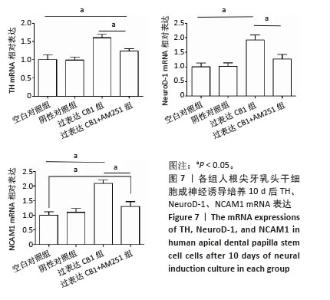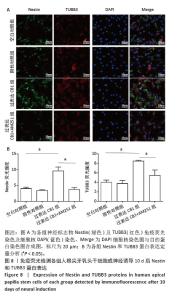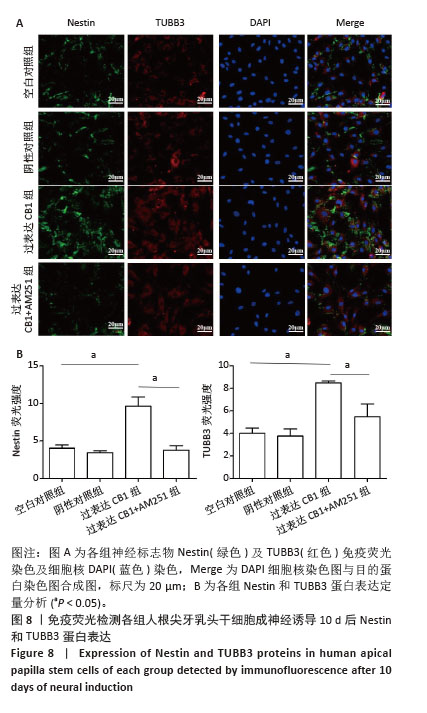Chinese Journal of Tissue Engineering Research ›› 2026, Vol. 30 ›› Issue (1): 93-100.doi: 10.12307/2026.509
Previous Articles Next Articles
Effect of cannabinoid type I receptors on neuronal differentiation of human apical papilla stem cells
Liu Ziwei, Nijati·Tursun, Yin Rui, Li Shuhui, Zhou Jing
- Department of Stomatology, Second Affiliated Hospital of Xinjiang Medical University, Urumqi 830063, Xinjiang Uygur Autonomous Region, China
-
Received:2024-10-25Accepted:2024-12-17Online:2026-01-08Published:2025-07-02 -
Contact:Zhou Jing, MS, Associate chief physician, Department of Stomatology, Second Affiliated Hospital of Xinjiang Medical University, Urumqi 830063, Xinjiang Uygur Autonomous Region, China -
About author:Liu Ziwei, Master candidate, Department of Stomatology, Second Affiliated Hospital of Xinjiang Medical University, Urumqi 830063, Xinjiang Uygur Autonomous Region, China -
Supported by:Xinjiang Uygur Autonomous Region Natural Science Foundation, No. 2022D01C274 (to ZJ)
CLC Number:
Cite this article
Liu Ziwei, Nijati·Tursun, Yin Rui, Li Shuhui, Zhou Jing. Effect of cannabinoid type I receptors on neuronal differentiation of human apical papilla stem cells[J]. Chinese Journal of Tissue Engineering Research, 2026, 30(1): 93-100.
share this article
Add to citation manager EndNote|Reference Manager|ProCite|BibTeX|RefWorks
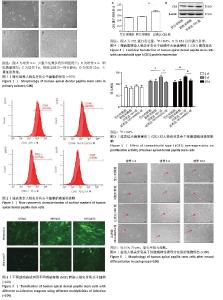
2.1 人根尖牙乳头干细胞形态 组织取材自新鲜拔除的牙根尚未发育完全的恒牙根尖部,酶消化法联合组织块法培养原代根尖牙乳头干细胞,培养3 d后发现培养瓶底部有少量不规则多角形细胞爬出(图1A),培养5 d后可见细胞数量增加,中央有卵圆形核,胞质向外伸出长短不同的突起(图1B),培养7 d后细胞呈现均一的长梭形(图1C),培养10 d后大量细胞聚集,相互紧密连接(图1D)。细胞生长速度快,融合度在70%-80%时,胰酶消化传代,扩大培养。 2.2 人根尖牙乳头干细胞流式鉴定结果 对人根尖牙乳头干细胞进行流式细胞术分析,结果显示,间充质干细胞标志物CD24、CD146和STRO-1表达率分别为93.5%,44.29%和35.79%,而造血干细胞标志物CD45表达率为0.00%,见图2。 2.3 慢病毒最佳感染条件 荧光显微镜下观察荧光强度,与其他两组相比,感染72 h后,HitransG A感染增强液、感染复数=10条件下,人根尖牙乳头干细胞感染效率达80%以上,荧光亮度表达最强,且细胞生长状况良好,见图3。因此,选取该条件进行后续慢病毒感染实验。 2.4 Western blot检测人根尖牙乳头干细胞内CB1的表达 与阴性对照组及空白对照组相比,过表达CB1组CB1蛋白表达量明显升高,差异有显著性意义(P < 0.05)。空白对照组与阴性对照组的CB1蛋白表达量无显著差异(P > 0.05),见图4。 2.5 细胞增殖检测结果 CCK-8检测结果显示:人根尖牙乳头干细胞成神经诱导第1天时,各组间吸光度值无明显差异。人根尖牙乳头干细胞成神经诱导第5,10天时,与空白对照组及阴性对照组相比,过表达CB1组人根尖牙乳头干细胞的增殖能力显著升高(P < 0.05);与过表达CB1组相比,过表达CB1+AM251组人根尖牙乳头干细胞的增殖能力显著下降(P < 0.05),见图5,提示CB1基因过表达促进人根尖牙乳头干细胞的增殖,AM251的加入抑制了人根尖牙乳头干细胞的增殖。 2.6 各组人根尖牙乳头干细胞形态 神经分化诱导1 d时可见少数具有细长形突起的星状细胞,细胞分布较为分散,各组间未见显著差异。神经分化诱导5 d时,与阴性对照组及空白对照组相比,过表达CB1组的细胞数量明显增多,细胞突起长度增长,分支数量增多,突起之间形成网络状连接;神经分化诱导10 d时,细胞增殖速度有所下降,细胞形态由梭形转变为圆形,形成了具有多极突起的典型神经细胞形态,表明CB1基因可促进人根尖牙乳头干细胞神经突起的生长。神经分化诱导第5,10天时,与过表达CB1相比,过表达CB1+AM251组细胞数量减少,胞质向外伸出两三个长短不同的突起,细胞间连接较为松散,神经细胞样形态不明显,提示AM251抑制人根尖牙乳头干细胞向神经细胞分化,见图6。"
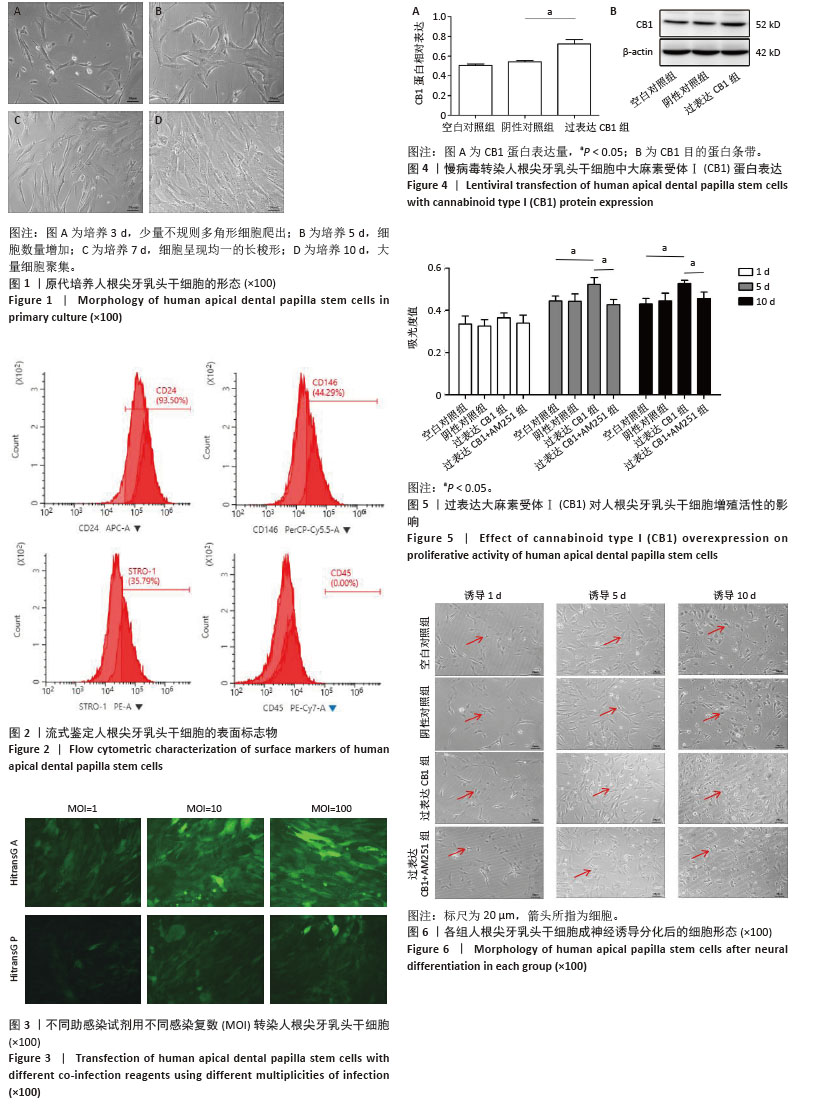
| [1] DILL-MACKY AS, LEE EN, WERTHEIM JA, et al. Glia in tissue engineering: From biomaterial tools to transplantation. Acta Biomater. 2024;190:24-49. [2] GUAN Y, REN Z, YANG B, et al. Dual-bionic regenerative microenvironment for peripheral nerve repair. Bioact Mater. 2023; 26:370-386. [3] QI T, ZHANG X, GU X, et al. Experimental Study on Repairing Peripheral Nerve Defects with Novel Bionic Tissue Engineering. Adv Healthc Mater. 2023;12(17): e2203199. [4] 高欣,孔令驰,史安琪,等.内芯外鞘神经导管的制备及表征[J].东华大学学报(自然科学版),2024,50(6):30-36. [5] FENG Y, LI Y, SHEN PP, et al. Gene-Modified Stem Cells for Spinal Cord Injury: a Promising Better Alternative Therapy. Stem Cell Rev Rep. 2022;18(8):2662-2682. [6] KONG H, LIU P, LI H, et al. Mesenchymal Stem Cell-Derived Extracellular Vesicles: The Novel Therapeutic Option for Regenerative Dentistry. Stem Cell Rev Rep. 2023;19(1):46-58. [7] 王钊鑫,尼加提·吐尔逊,代慧娟,等.巨噬细胞炎性蛋白1α对人牙周膜干细胞生物学行为的影响[J].中国组织工程研究,2023, 27(10):1521-1527. [8] MEAD B, LOGAN A, BERRY M, et al. Concise Review: Dental Pulp Stem Cells: A Novel Cell Therapy for Retinal and Central Nervous System Repair. Stem Cells. 2017;35(1):61-67. [9] 蔡韵竹,朱姝,刘尧,等.牙源性干细胞用于治疗神经系统疾病的研究进展[J].国际口腔医学杂志,2022,49(3):255-262. [10] BASABRAIN MS, ZHONG J, LUO H, et al. Formation of Three-Dimensional Spheres Enhances the Neurogenic Potential of Stem Cells from Apical Papilla. Bioengineering (Basel). 2022;9(11):604. [11] NGAI P, LEE AHC, XU J, et al. Effects of L-Chg10-Teixobactin on Viability, Proliferation, and Osteo/Odontogenic Differentiation of Stem Cells from Apical Papilla. J Endod. 2023;49(2):162-168. [12] XIAO Y, CHEN L, XU Y, et al. Circ-ZNF236 mediates stem cells from apical papilla differentiation by regulating LGR4-induced autophagy. Int Endod J. 2024;57(4):431-450. [13] MARTENS W, BRONCKAERS A, POLITIS C, et al. Dental stem cells and their promising role in neural regeneration: an update. Clin Oral Investig. 2013;17(9):1969-1983. [14] SONGSAAD AT, THAIRAT S, SEEMAUNG P, et al. Characterization of neural stem cells derived from human stem cells from the apical papilla undergoing three-dimensional neurosphere induction. J Appl Oral Sci. 2023;31:e20230209. [15] MOLINA-HOLGADO E, ESTEBAN PF, AREVALO-MARTIN Á, et al. Endocannabinoid signaling in oligodendroglia. Glia. 2023;71(1):91-102. [16] SELVARAJ P, TANAKA M, WEN J, et al. The Novel Monoacylglycerol Lipase Inhibitor MJN110 Suppresses Neuroinflammation, Normalizes Synaptic Composition and Improves Behavioral Performance in the Repetitive Traumatic Brain Injury Mouse Model. Cells. 2021;10(12): 3454. [17] RAMESH K, ROSENBAUM DM. Molecular basis for ligand modulation of the cannabinoid CB1 receptor. Br J Pharmacol. 2022;179(14):3487-3495. [18] MONTEIRO VIANA JC, DA SILVA GOMES GE, DUARTE OLIVEIRA FJ, et al. The Role of Different Types of Cannabinoids in Periodontal Disease: An Integrative Review. Pharmaceutics. 2024;16(7):893. [19] BLANDO S, RAFFAELE I, CHIRICOSTA L, et al. Cannabidiol Promotes Neuronal Differentiation Using Akt and Erk Pathways Triggered by Cb1 Signaling. Molecules. 2022;27(17):5644. [20] SOUNDARA RAJAN T, GIACOPPO S, SCIONTI D, et al. Cannabidiol Activates Neuronal Precursor Genes in Human Gingival Mesenchymal Stromal Cells. J Cell Biochem. 2017;118(6):1531-1546. [21] 马玉,段子文,李淑慧,等.牙周膜干细胞与根尖牙乳头干细胞成骨及成牙本质能力比较的实验研究[J].口腔医学,2018,38(1):5-9. [22] ZIPSER CM, CRAGG JJ, GUEST JD, et al. Cell-based and stem-cell-based treatments for spinal cord injury: evidence from clinical trials. Lancet Neurol. 2022;21(7):659-670. [23] SONGSAAD A, GONMANEE T, RUANGSAWASDI N, et al. Potential of resveratrol in enrichment of neural progenitor-like cell induction of human stem cells from apical papilla. Stem Cell Res Ther. 2020; 11(1):542. [24] SHEN Z, TSAO H, LARUE S, et al. Vascular Endothelial Growth Factor and/or Nerve Growth Factor Treatment Induces Expression of Dentinogenic, Neuronal, and Healing Markers in Stem Cells of the Apical Papilla. J Endod. 2021;47(6):924-931. [25] BLEBEA NM, PRICOPIE AI, VLAD RA, et al. Phytocannabinoids: Exploring Pharmacological Profiles and Their Impact on Therapeutical Use. Int J Mol Sci. 2024;25(8):4204. [26] ABIDI AH, ABHYANKAR V, ALGHAMDI SS, et al. Phytocannabinoids regulate inflammation in IL-1β-stimulated human gingival fibroblasts. J Periodontal Res. 2022;57(6):1127-1138. [27] MARTINEZ RAMIREZ CE, RUIZ-PÉREZ G, STOLLENWERK TM, et al. Endocannabinoid signaling in the central nervous system. Glia. 2023; 71(1):5-35. [28] 李永丰,任维,刘一辉.CB1受体通过钾离子通道介导外周镇痛作用[J].中国病理生理杂志,2019,35(4):660-666. [29] MADHUBALA D, PATRA A, KHAN MR, et al. Phytomedicine for neurodegenerative diseases: The road ahead. Phytother Res. 2024; 38(6):2993-3019. [30] 乐明霞,周瑞,黄杜娟,等.大麻素-CB1/CB2受体系统对多巴胺神经元调节作用及其与帕金森病发生的研究进展[J].神经解剖学杂志,2017,33(6):753-757. [31] 王海军,牛亚凯,陈巍.内源性大麻素系统在运动促进脑健康中的研究进展[J].生命科学,2021,33(9):1096-1103. [32] MORRIS G, WALDER K, KLOIBER S, et al. The endocannabinoidome in neuropsychiatry: Opportunities and potential risks. Pharmacol Res. 2021;170:105729. [33] HU M, ZHU D, ZHANG J, et al. Enhancing endocannabinoid signalling in astrocytes promotes recovery from traumatic brain injury. Brain. 2022;145(1):179-193. [34] MENESES CCB, PIZZATTO LN, SIPERT CR, et al. Endocannabinoids Regulate Stem Cells of the Apical Papilla via a Cannabinoid Receptor and TRPV1-Independent Mechanism. J Endod. 2021;47(10): 1617-1624. [35] QUE K, HE D, JIN Y, et al. Expression of Cannabinoid Type 1 Receptors in Human Odontoblast Cells. J Endod. 2017;43(2):283-288. [36] PATASKAR A, JUNG J, SMIALOWSKI P, et al. NeuroD1 reprograms chromatin and transcription factor landscapes to induce the neuronal program. EMBO J. 2016;35(1):24-45. [37] PARCERISAS A, ORTEGA-GASCÓ A, PUJADAS L, et al. The Hidden Side of NCAM Family: NCAM2, a Key Cytoskeleton Organization Molecule Regulating Multiple Neural Functions. Int J Mol Sci. 2021;22(18):10021. [38] 李含章,李亚楠,郭磊,等.电针对帕金森病小鼠肠道NEK7/NLRP3炎症信号通路的影响[J].北京中医药大学学报,2024,47(10): 1466-1473. [39] FERNÁNDEZ-RUIZ J, GÓMEZ M, HERNÁNDEZ M, et al. Cannabinoids and gene expression during brain development. Neurotox Res. 2004; 6(5):389-401. [40] VALERI A, CHIRICOSTA L, GUGLIANDOLO A, et al. Cannabinerol and NSC-34 Transcriptomic Analysis: Is the Dose Who Makes Neuronal Differentiation. Int J Mol Sci. 2022;23(14):7541. [41] SIMONOVIC J, TOLJIC B, LAZAREVIC M, et al. The Effect of Liquid-Phase Exfoliated Graphene Film on Neurodifferentiation of Stem Cells from Apical Papilla. Nanomaterials (Basel). 2022;12(18):3116. [42] RADWITZ J, HAUSRAT TJ, HEISLER FF, et al. Tubb3 expression levels are sensitive to neuronal activity changes and determine microtubule growth and kinesin-mediated transport. Cell Mol Life Sci. 2022;79(11):575. [43] XAPELLI S, AGASSE F, SARDÀ-ARROYO L, et al. Activation of type 1 cannabinoid receptor (CB1R) promotes neurogenesis in murine subventricular zone cell cultures. PLoS One. 2013;8(5):e63529. [44] 孙军,娄雅昕,苏凡,等.花生四烯酸氨基乙醇对人成牙本质细胞样细胞MMP-9表达的影响[J].北京口腔医学,2023,31(6):385-390. [45] YAN W, CAO Y, YANG H, et al. CB1 enhanced the osteo/dentinogenic differentiation ability of periodontal ligament stem cells via p38 MAPK and JNK in an inflammatory environment. Cell Prolif. 2019;52(6):e12691. |
| [1] | Haonan Yang, Zhengwei Yuan, Junpeng Xu, Zhiqi Mao, Jianning Zhang. Preliminary study on the mechanisms and efficacy of deep brain stimulation in treating depression [J]. Chinese Journal of Tissue Engineering Research, 2026, 30(在线): 1-9. |
| [2] | Sun Lei, Zhang Qi, Zhang Yu. Pro-osteoblastic effect of chlorogenic acid protein microsphere/polycaprolactone electrospinning membrane [J]. Chinese Journal of Tissue Engineering Research, 2026, 30(8): 1877-1884. |
| [3] | Wang Qisa, Lu Yuzheng, Han Xiufeng, Zhao Wenling, Shi Haitao, Xu Zhe. Cytocompatibility of 3D printed methyl acrylated hyaluronic acid/decellularized skin hydrogel scaffolds [J]. Chinese Journal of Tissue Engineering Research, 2026, 30(8): 1912-1920. |
| [4] | Huang Liuyan, Zhang Wenxi, Chen Shuwen, Yu Shimei, Dai Zhong, Zuo Changqing. Forskolin promotes C2C12 myoblast differentiation via regulating the ERK and Akt signaling pathways [J]. Chinese Journal of Tissue Engineering Research, 2026, 30(5): 1114-1121. |
| [5] | Bao Zhuoma, Hou Ziming, Jiang Lu, Li Weiyi, Zhang Zongxing, Liu Daozhong, Yuan Lin. Effect and mechanism by which Pterocarya hupehensis skan total flavonoids regulates the proliferation, migration and apoptosis of fibroblast-like synoviocytes [J]. Chinese Journal of Tissue Engineering Research, 2026, 30(4): 816-823. |
| [6] | Chen Ling, Mao Qiuhua, Xu Pu, Zhang Wenbo. Effect of water-soluble matrix of nano-pearl powder on proliferation, migration and apoptosis of mouse fibroblasts#br# [J]. Chinese Journal of Tissue Engineering Research, 2026, 30(2): 338-344. |
| [7] | Wu Zhijing, Li Jiali, Zhang Jiaxin, Wang Tangrong, Zheng Yuzhou, Sun Zixuan. Alpha-ketoglutarate engineered small extracellular vesicles delay skin aging [J]. Chinese Journal of Tissue Engineering Research, 2026, 30(1): 120-129. |
| [8] | Zhao Yang, Li Jialin, Wu Xiao, Zou Yourui, Liu Yang, Ma Hui. Choline kinase alpha silencing affects proliferation and apoptosis in glioma cells by inducing mitochondrial dysfunction [J]. Chinese Journal of Tissue Engineering Research, 2026, 30(1): 130-138. |
| [9] | Xue Hui, Li Dongnan, Zhao Yadi, Chen Chao, Xie Zongyuan. Relationship between BCR/ABL gene expression and recurrence before and after allogeneic transplantation in Ph chromosome positive acute lymphoblastic leukemia [J]. Chinese Journal of Tissue Engineering Research, 2026, 30(1): 139-144. |
| [10] | Lyu Ruyue, Gu Lulu, Liu Qian, Zhou Siyi, Li Beibei, Xue Letian, Sun Peng. Regulatory mechanisms of exosome secretion and its application prospects in biomedicine [J]. Chinese Journal of Tissue Engineering Research, 2026, 30(1): 184-193. |
| [11] | Luo Wenbin, Li Ruoyun, Pan Chaofan, Luo Changjiang. Engineered exosomes for repairing tissue damage: application potential, excellent biological stability, and targeting specificity [J]. Chinese Journal of Tissue Engineering Research, 2026, 30(1): 204-217. |
| [12] | Yao Lijie, Yan Yuying, Chen Siyu, Wang Yuanfei, Wu Tong. Nanofibers with gradient deposition of endothelial cell derived matrix particles modulate the behavior of Schwann cells [J]. Chinese Journal of Tissue Engineering Research, 2025, 29(在线): 1-10. |
| [13] | Li Zikai, Zhang Chengcheng, Xiong Jiaying, Yang Xirui, Yang Jing, Shi Haishan. Potential effects of ornidazole on intracanal vascularization in endodontic regeneration [J]. Chinese Journal of Tissue Engineering Research, 2025, 29(在线): 1-7. |
| [14] | Zhang Yibo, Lu Jianqi, Mao Meiling, Pang Yan, Dong Li, Yang Shangbing, Xiao Xiang. Exploring the causal relationship between rheumatoid arthritis and coronary atherosclerosis: a Mendel randomized study involving serum metabolites and inflammatory factors [J]. Chinese Journal of Tissue Engineering Research, 2025, 29(在线): 1-9. |
| [15] | Xu Hao, Ding Lu, Li Xiao. Investigating the effect of the mechanical wear on abutment screw in Morse taper connection implant implant system by using finite element analysis [J]. Chinese Journal of Tissue Engineering Research, 2025, 29(在线): 1-9. |
| Viewed | ||||||
|
Full text |
|
|||||
|
Abstract |
|
|||||
